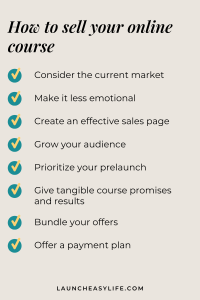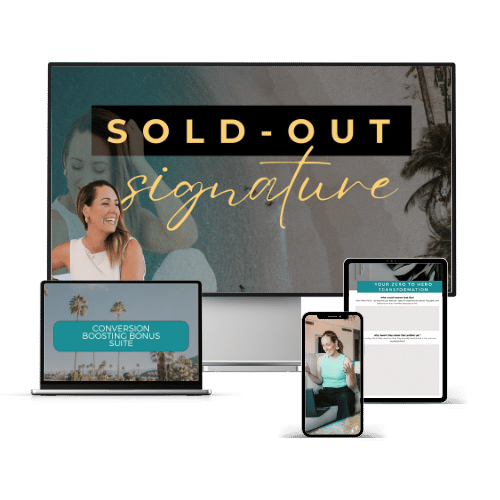The online education industry is expected to reach over $200 billion in 2025. Courses are selling more than ever, but you need to know how to sell an online course to see your desired results.
Selling an online course can be the most rewarding and beneficial step you take in your business. In fact, it helped me quit my corporate management role so I could work from home, attend all my children’s assemblies, and never stress about childcare during breaks. I can also take off for adventures and holidays whenever we want – all while still earning more than I did in corporate management.
Below, I’ll discuss what to consider if your course launch failed and how you can actually make money selling courses.
What to know if your course launch failed
If your course launch didn’t bring the results you wanted, you’re not alone. It’s not uncommon for the first launch to flop, especially if you’re unsure of the right steps to take. The good news is that you can revamp your processes and move forward to make money selling your course.
There are usually great lessons to learn from a failed course launch. Consider these questions: Did you consider the current market? Did you run a prelaunch? What marketing strategies did you implement? What transformation are you promising? We’ll dive more into these below.
How to sell an online course: here’s what actually works
To successfully sell your online course, it’s important to look at what went wrong during your launch and ensure you effectively market and launch your course next time.

Consider the current market
A few years ago, many people were interested in upskilling, so self-study and DIY courses sold very well. Now, people are exhausted and don’t have the capacity to sit through hours of material.
The current market is looking for results they can achieve through straightforward programs, accountability, and human connection, so you need to make sure your course offers this.
This might require updating your course’s content, including a community aspect, and showcasing these features when marketing the course.
Make it less emotional
While involving your emotions in your business is normal, it’s crucial to understand that successful course launches aren’t about you. They’re about the data.
This is why one of the main priorities we discuss in the Peace + Profit Mastermind is dissecting your launch to figure out what didn’t work so you can fix it for more sales in the future.
When analyzing data, you can look at the following and make changes accordingly.
- Common objections – What seems to be holding people back, and how can you fill this gap? This might require speaking to your audience.
- Email open and conversion rates – Look at which emails perform best and which ones don’t. Consider the timing, content, subject lines, etc.
- Webinar data – Identify patterns and trends in attendance, engagement, and conversion rates.
- Audience size – Online courses typically convert at a rate of 1 to 2%. When considering this, does your audience size allow for a successful launch?
Create an effective sales page
Your sales page is the primary tool for encouraging people to buy, so it needs to be written to convert. There’s a good chance you can make some improvements to help you sell more courses.
When updating your sales page, make sure it has the following:
- An emotion-provoking headline – This will likely be your course name and should clearly showcase the course’s value to create a sense of excitement.
- Supporting subheadline – Include a one- to two-sentence description naming the problem your target audience is facing and explaining how the course will help them fix it.
- Call to actions – Include a few CTAs throughout your sales page with specific, actionable wording like “Purchase the course!” and “Buy the course now!”
- Video(s) – Nearly 40% of marketers say video is the leading impact for conversion, so consider including a course intro and/or testimonial(s) via video.
- Benefits – Describe how the course experience and outcome will benefit students.
- Social proof – About 40% of consumers are more likely to buy a product with reviews, so sharing written and/or video testimonials on your landing page could help you make more sales.
- FAQs – You can answer common questions to bridge the gap for those unsure if the course is for them. Answer questions like who the course is for, what people can achieve from it, how it’s set up, etc.
Grow your audience
Successfully selling an online course is a numbers game, so growing your audience is essential. While this can take time, and warm leads are better than a huge following, having more eyes on your offer is often helpful.
Some of the best ways to build your audience include:
- Social media
- Email marketing
- Podcasting
- Blogging
Prioritize your prelaunch
I work with many people who “run out of time for prelaunch” and then head into their promotion period with an ‘oopsie’ mindset, hoping to make the same number of sales. However, you’ll see little to no results from your launch without an effective prelaunch strategy.
I suggest a 90-day launch period with the following steps:
- Breakthrough build-up – About one to two months before your launch, use your lead magnet to build and nurture your email list, build your launch waitlist, and create content that teases your course.
- Breakthrough conversion event – About two weeks before your launch, promote and lead a live event around your course topic to build authority and trust. Use this time to also share your course details. This can be a webinar, a 3-day challenge, a paid workshop, or a free trial.
- Cart open – Spend about two weeks selling your course, starting on the day of your conversion event. Share your marketing message with your audience, run ads, and talk to warm leads to make as many sales as possible.
Give tangible course promises and results
A common mistake I see in failed launches is vague, fluffy promises and outcomes. This usually shows through in marketing material and turns people off from buying.
To successfully sell an online course, the outcome you’re promising should be tangible and results-focused. This allows people to really understand what they’re buying and what they’ll achieve from your course.
Bundle your offers
If you have multiple courses or other offers related to the same topics, you can bundle and sell them at a discounted price. This creates an incentive for people to purchase from you as they can get more for their money.
For example, my Peace + Profit Mastermind includes access to all of my trainings for course creators and service providers who want to earn six figures in part-time hours.
Offer a payment plan
A payment plan for your course is an effective way to meet more people where they are. A good sweet spot is having 50% of your course students pay in full and the other 50% take up a payment plan.
I typically recommend splitting the plan into payments that match the duration of your program. For example, if it’s a 3-month program, you could split it into 3 monthly payments or six bi-weekly payments.
That said, in the current economy, some providers use extended payment plans. This has worked really well for my offers, too.
How to sell your online course: additional resources
- Signature Online Course Secrets – My podcast for women who want to grow and scale a profitable and peaceful online business
- Tools and tech – My little black book of tech, suppliers, and software to help you build your online business with ease (including Kartra, my favorite online course platform)
- Peace + Profit Mastermind – An intimate, 6-month program for established female service providers, consultants, and course creators who want to double their revenue while working 20 hours or less per week

